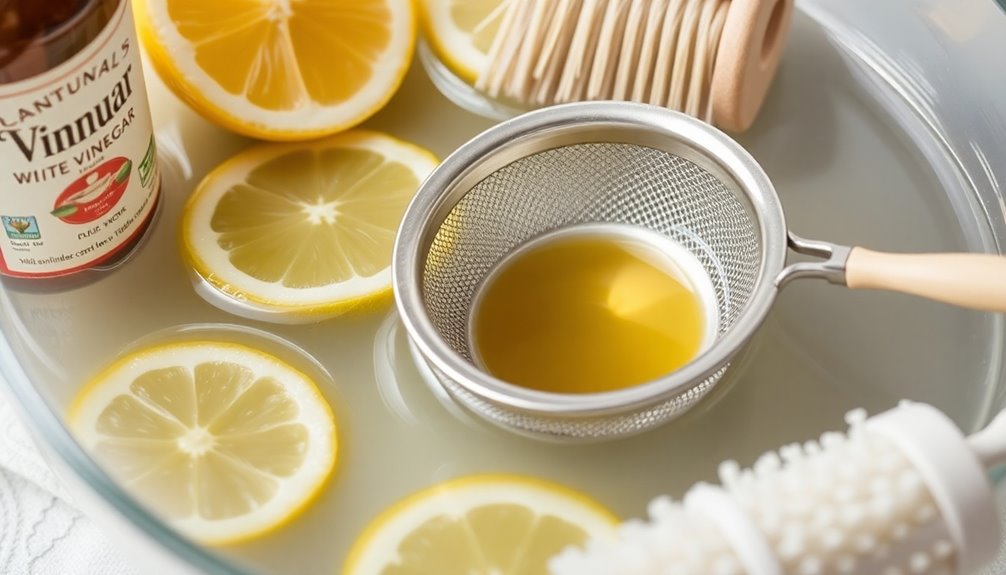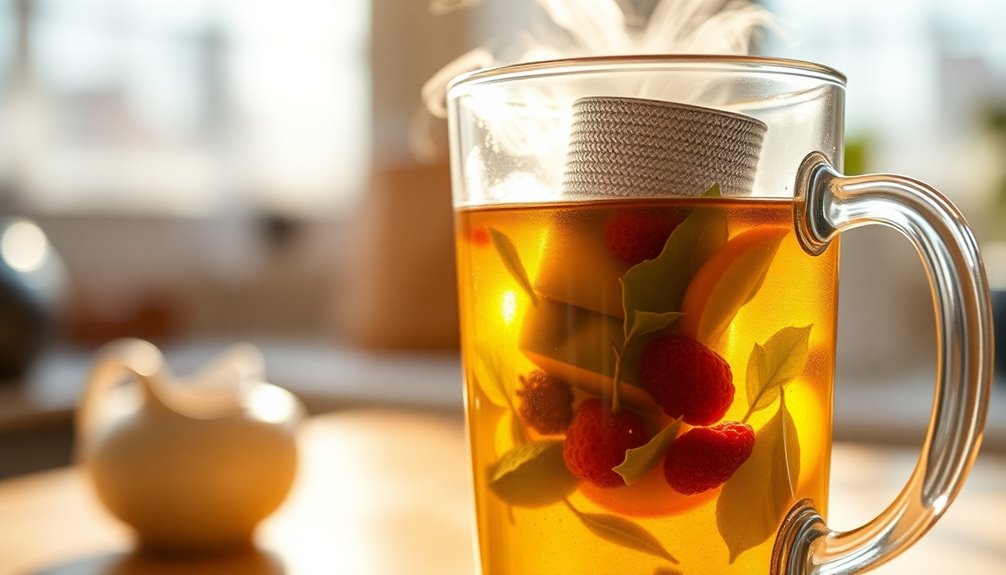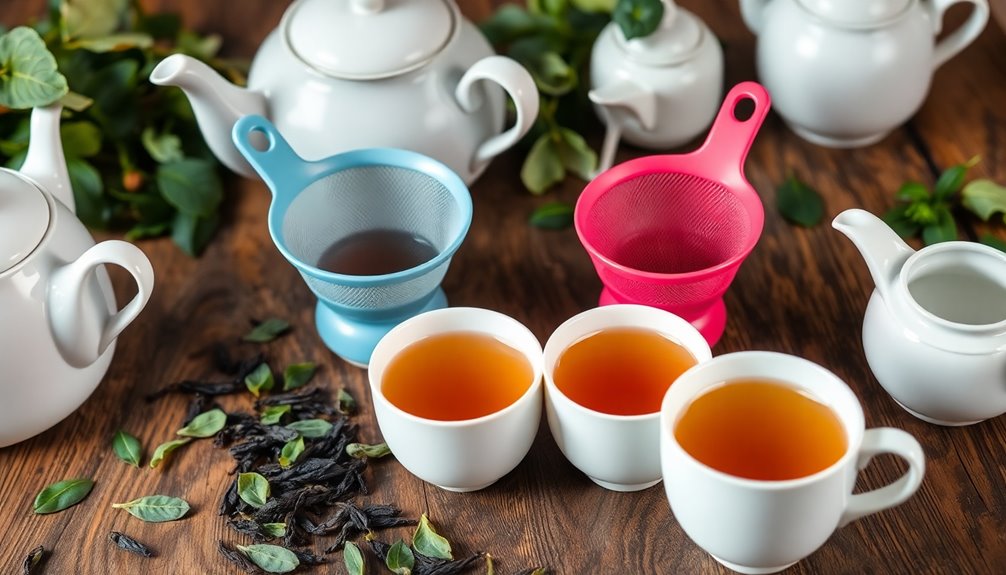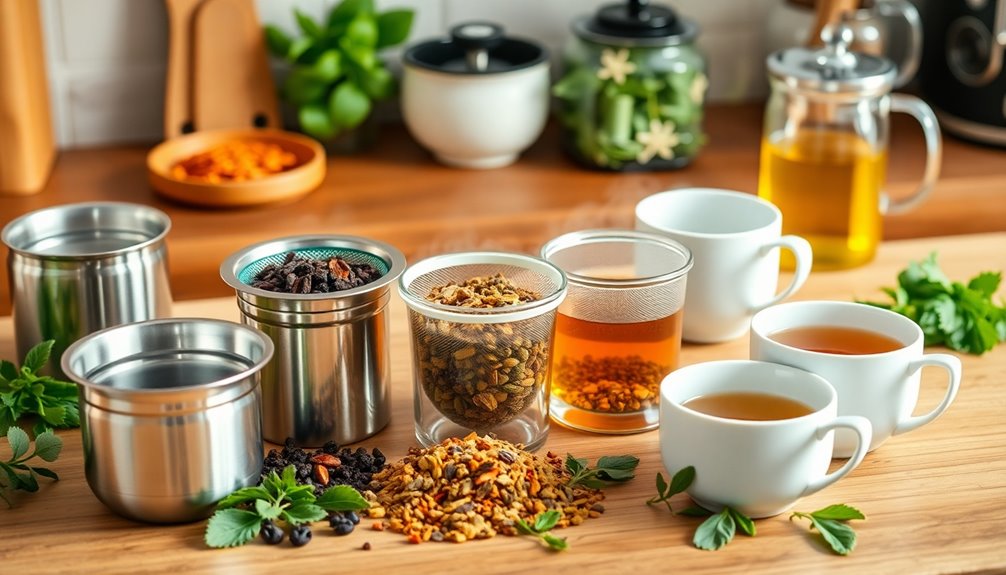To clean your tea infuser without damaging it, start by rinsing it with warm water right after use to prevent residue buildup. For stainless steel, use vinegar or baking soda; for plastic, a mild dish soap is best. Silicone infusers can be cleaned with hot water and gentle scrubbing. For glass and ceramic, opt for non-abrasive cleaners and avoid harsh chemicals. Soaking in a vinegar solution or baking soda can help with tougher stains. Regular maintenance will ensure your infuser lasts longer and brews delicious tea. Discover even more effective cleaning tips and tricks ahead!
Key Takeaways
- Rinse the tea infuser with warm water immediately after use to prevent residue buildup and maintain flavor integrity.
- For stainless steel infusers, soak them in a vinegar or baking soda solution to effectively remove stains without damage.
- Use mild dish soap and warm water for cleaning plastic infusers, avoiding harsh chemicals to prevent degradation.
- Clean silicone infusers with hot water and gentle scrubbing, steering clear of extreme heat to preserve their shape and integrity.
- Regularly inspect your infuser for wear and tear, ensuring it remains in good condition for optimal performance.
Introduction
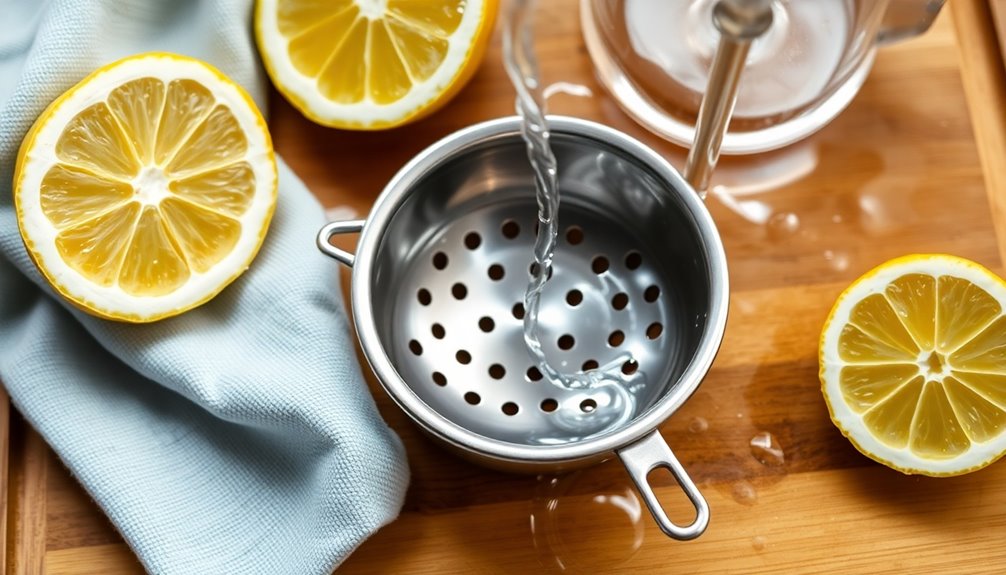
Keeping your tea infuser clean is essential for enjoying the best flavor from your brews. A clean tea strainer not only enhances the taste of your tea but also helps prevent residue buildup that can affect future infusions.
After each use, rinse your infuser promptly with warm water to remove any leftover tea particles. For deeper cleaning, consider soaking your infuser in a solution of warm water and vinegar or baking soda overnight. Both methods effectively remove tea stains without damaging the material.
Using mild dish soap and a soft-bristled brush can also help you clean mesh infusers gently, ensuring you don't scratch any delicate components. Regular maintenance is key; make it a habit to deep clean your infuser periodically for optimal performance.
If you notice stubborn stains, don't hesitate to soak the infuser in vinegar to improve shine and reduce discoloration. Just be sure to rinse it thoroughly afterward to avoid any residual odors.
Material Types Affect Cleaning Methods
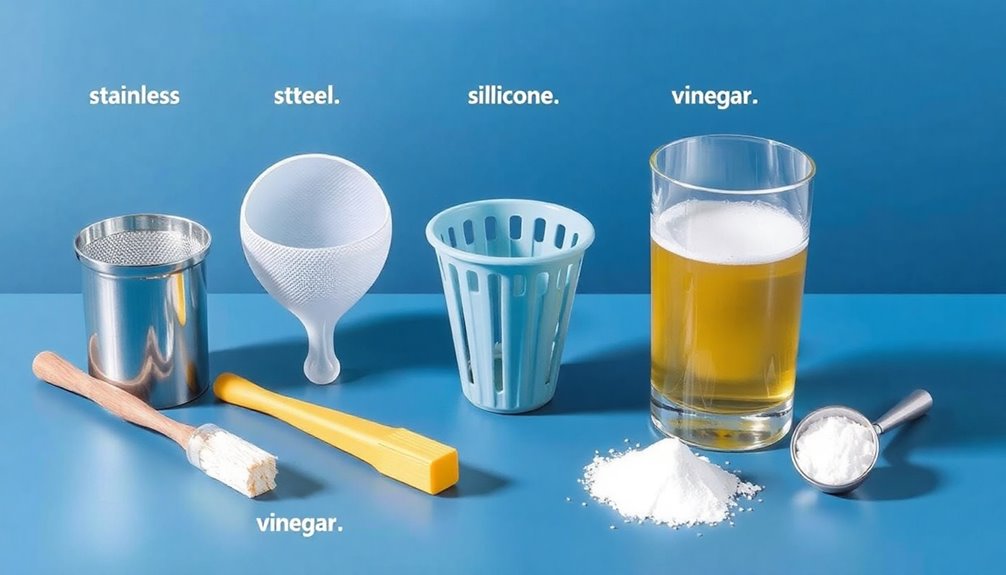
Different materials require specific cleaning methods to maintain the integrity of your tea infuser.
For stainless steel, you can confidently use various cleaning methods, including soaking in vinegar or baking soda solutions, as it's durable and resistant to corrosion.
If you have a plastic infuser, clean it with mild dish soap and warm water. Be sure to avoid harsh chemicals like bleach, which could damage the material and cause staining.
For silicone infusers, hot water and gentle scrubbing work best, but steer clear of extreme heat and abrasive cleaners to prevent damage.
Glass tea infusers need special care—use non-abrasive cleaning solutions and soft cloths to avoid scratches while keeping the glass clear.
Lastly, ceramic strainers should be washed gently with mild detergents, and you must avoid drastic temperature changes to prevent cracking.
Cleaning Methods Vary by Material
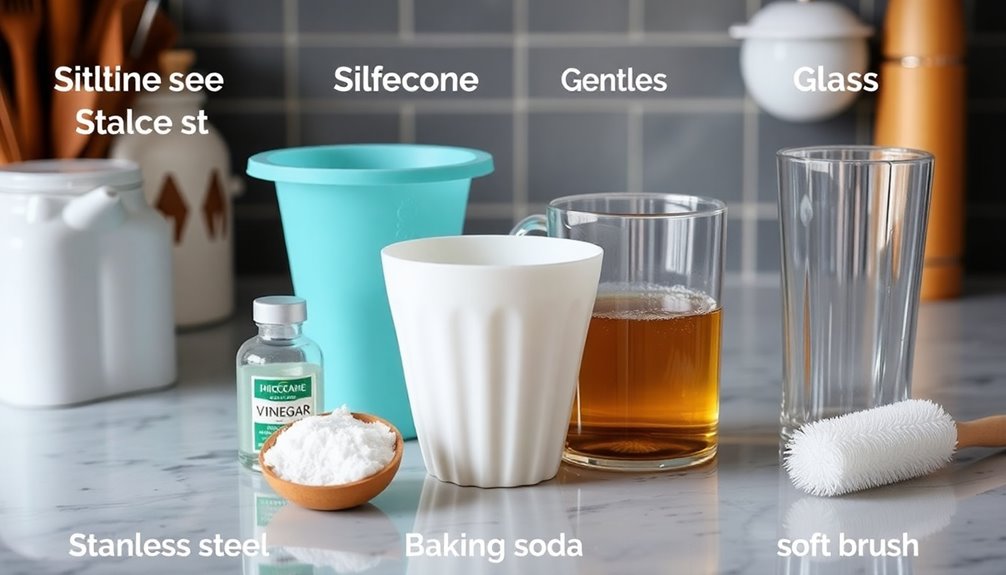
While each type of tea infuser has its unique cleaning requirements, understanding these methods ensures you maintain their longevity and performance.
For metal strainers, you can use a baking soda solution or an alcohol soak to effectively remove stains without damaging the metal.
When you clean your tea strainer made of plastic, stick to mild dish soap and warm water, as harsh chemicals can degrade or discolor the plastic.
For silicone strainers, warm, soapy water or a vinegar solution works best—just avoid abrasive cleaners that might scratch the surface.
If you're dealing with glass or ceramic strainers, you can use more aggressive cleaning methods, such as soaking in vinegar, but handle these materials with care to prevent chipping or breaking.
It's crucial to avoid harsh chemicals, especially for aluminum or alloy strainers, as caustic soda or bleach can cause significant corrosion.
No matter the material, a good job starts with proper care.
For all types, using water to clean and letting them soak when necessary will help keep your tea strainers in top shape.
Eco-Friendly Cleaning Solutions
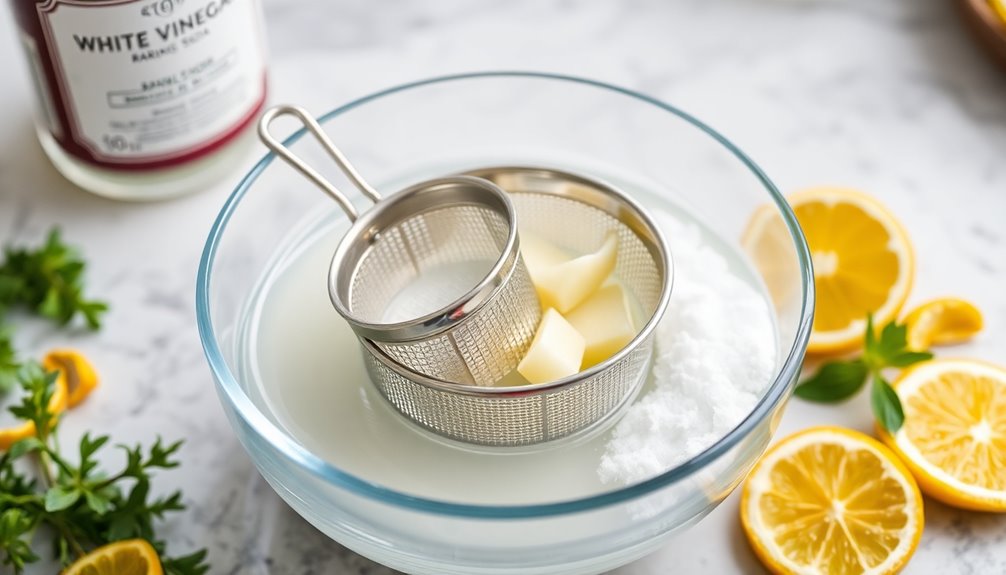
When it comes to cleaning your tea infuser, eco-friendly solutions can effectively tackle stubborn stains and odors without harming the environment.
Start by using a baking soda solution; mix 1 teaspoon of baking soda with hot water and soak your tea strainer for a few hours or overnight. This not only helps in removing stains but does so without harsh chemicals.
Another great option is white vinegar. Combine equal parts white vinegar and water, then soak your infuser overnight. This method eliminates stubborn stains and odors, making it safe for both metal and plastic materials.
For regular maintenance, consider using lemon juice mixed with warm water. This natural disinfectant breaks down tea residue while leaving a refreshing scent.
If you need a deep clean, try a diluted hydrogen peroxide solution (1 part peroxide to 4 parts water) to remove stains without damaging your infuser.
Lastly, you can't go wrong with a few drops of natural dish soap. Opt for biodegradable and non-toxic options to ensure a good clean tea experience while being kind to the planet.
Cleaning vs. Material Durability
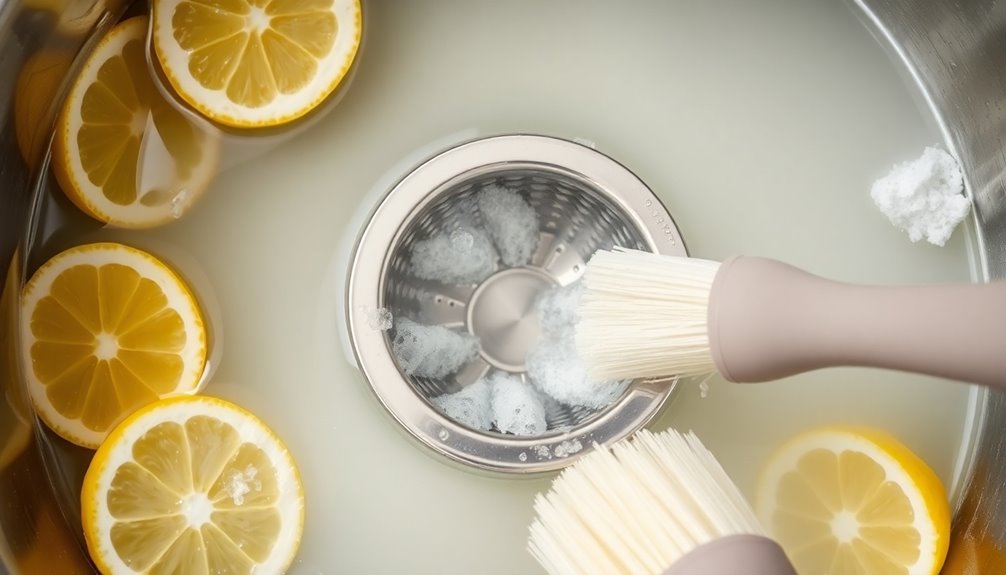
Choosing the right cleaning method for your tea infuser is closely linked to the material it's made from. If your infuser is stainless steel, you're in luck—this material can withstand aggressive cleaning techniques. You can safely soak it in solutions like vinegar or baking soda to remove stubborn stains. Just remember to rinse it thoroughly with water afterward.
On the other hand, plastic infusers require more caution. They're more prone to staining and damage from harsh chemicals, which can shorten their lifespan. Stick to mild soap and warm water for cleaning, and avoid abrasive scrubbing tools that could scratch the surface.
If you own an infuser made from delicate materials, like fine mesh, take extra care. Gentle cleaning techniques are crucial here to prevent tears or structural damage. Soaking mightn't be the best option, as it could lead to degradation.
Always check the manufacturer's guidelines for specific cleaning instructions tailored to your tea infuser's material. By choosing the right cleaning method, you can ensure your infuser remains in great condition for many brewing sessions to come.
Practical Applications

Maintaining your tea infuser goes beyond just occasional cleaning; it's about integrating practical habits into your routine.
To effectively clean a tea infuser, rinse it with warm water right after each use. This helps prevent tea residue from drying and becoming difficult to remove.
For deeper cleaning, soak the tea strainer in a solution of one teaspoon of baking soda mixed with boiling water for four hours or overnight. This will help to break down any stubborn stains.
After soaking, grab an old toothbrush to gently scrub the mesh basket, avoiding abrasive materials that can damage its surface.
Regularly inspect your infuser for any signs of wear, like tears in the mesh or rust spots. If you notice significant damage, consider replacing it to maintain optimal tea brewing quality. Additionally, keeping your infuser clean enhances the unique flavor profile of the oolong tea you enjoy, ensuring that each brew delivers the best taste.
Conclusion
In conclusion, keeping your tea infuser clean is essential for maintaining the flavor of your brews. By understanding the material of your infuser, you can choose the right cleaning method that won't cause damage. Whether you opt for eco-friendly solutions or simple soap and water, regular maintenance will ensure your infuser lasts longer and brews better. So go ahead, give your infuser some love, and enjoy every delicious cup of tea!

